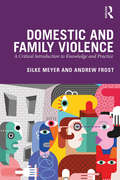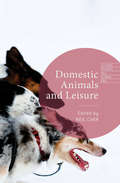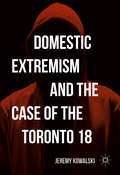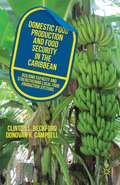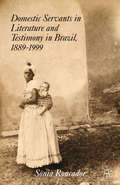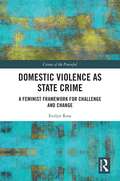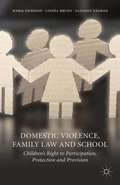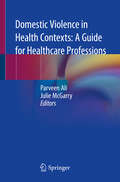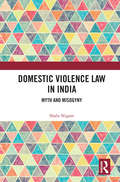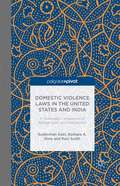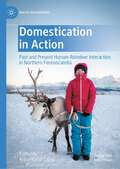- Table View
- List View
Domestic and Family Violence: A Critical Introduction to Knowledge and Practice
by Silke Meyer Andrew FrostDomestic and family violence (DFV) is an enduring social and public health issue of endemic proportions and global scale, with multiple and lasting consequences for those directly affected. This book tackles current debates in the field and addresses the social norms and settings that perpetuate this type of violence, along with implications for service delivery. The book offers a thorough introduction into the nature and extent of DFV in contemporary social contexts and serves as a foundation for informed practice. It provides a firm theoretical and empirical overview of core issues, covering the challenges and support needs experienced by those affected, along with the implications this raises for the range of relevant response services. The authors also offer insight into the predominantly gendered nature of DFV and its influence beyond the traditional couple context, across age, gender, sexual orientation, cultural background, and family relationships. Drawing on theoretical explanations, international research, and practice experience, they highlight examples of good practice and holistic responses, including primary, secondary, and tertiary prevention. Written in a clear and direct style, this book will appeal to students and scholars of criminology, sociology, and social work engaged in studies of domestic and family violence, violence against women, and intimate partner violence. It will be an invaluable resource for those designing, coordinating, and conducting service responses.
Domestic and Family Violence: A Critical Introduction to Knowledge and Practice
by Silke Meyer Andrew FrostDomestic and family violence (DFV) is an enduring social and public health issue of endemic proportions and global scale, with multiple and lasting consequences for those directly affected. This book tackles current debates in the field and addresses the social norms and settings that perpetuate this type of violence, along with implications for service delivery. The book offers a thorough introduction into the nature and extent of DFV in contemporary social contexts and serves as a foundation for informed practice. It provides a firm theoretical and empirical overview of core issues, covering the challenges and support needs experienced by those affected, along with the implications this raises for the range of relevant response services. The authors also offer insight into the predominantly gendered nature of DFV and its influence beyond the traditional couple context, across age, gender, sexual orientation, cultural background, and family relationships. Drawing on theoretical explanations, international research, and practice experience, they highlight examples of good practice and holistic responses, including primary, secondary, and tertiary prevention. Written in a clear and direct style, this book will appeal to students and scholars of criminology, sociology, and social work engaged in studies of domestic and family violence, violence against women, and intimate partner violence. It will be an invaluable resource for those designing, coordinating, and conducting service responses.
Domestic Animals and Leisure: Rights, Welfare, And Wellbeing (Leisure Studies in a Global Era)
by Neil CarrThis volume offers both an insight into the current state of research on domestic animals in leisure and a lens through which to begin to chart the future of research in this field. All of the contributions to the collection are underpinned by ongoing debates about human-animal relationships and the rights and welfare of the latter.
The Domestic Domain: Chances, Choices and Strategies of Family Households (Routledge Revivals)
by Paul Pennartz Anke NiehofFirst published in 1999, the primary focus of this book is what goes on inside the ‘black box’ of households, beginning with decision-making but branching out to develop a comprehensive view of the domestic domain. It brings together theoretical frameworks relevant to the study of family households from several root disciplines, each framework highlighting a different approach. Each approach is applied to important problems concerning the functioning of family households. The book focuses on households and their members as active agents who manage both material and immaterial resources. The private sector, to which family households belong, is not viewed as just responding to impulses from the formal economy and to public policies, but as a dynamic system in its own right. In the view of Paul Pennartz and Anke Niehof, households not only accommodate to social change but also mediate and generate social change. In the book key studies are presented which exemplify approaches and issues. The key studies cover a wide range of societies in Europe, North and Latin America, Asia and Africa, thus also exemplifying the comparative perspective, which is another important feature of the book. Pennartz and Niehof examine issues including the organisational approach and resource allocation, the power approach and the division of household production tasks and the opportunity structure approach and the housing market.
The Domestic Domain: Chances, Choices and Strategies of Family Households (Routledge Revivals)
by Paul Pennartz Anke NiehofFirst published in 1999, the primary focus of this book is what goes on inside the ‘black box’ of households, beginning with decision-making but branching out to develop a comprehensive view of the domestic domain. It brings together theoretical frameworks relevant to the study of family households from several root disciplines, each framework highlighting a different approach. Each approach is applied to important problems concerning the functioning of family households. The book focuses on households and their members as active agents who manage both material and immaterial resources. The private sector, to which family households belong, is not viewed as just responding to impulses from the formal economy and to public policies, but as a dynamic system in its own right. In the view of Paul Pennartz and Anke Niehof, households not only accommodate to social change but also mediate and generate social change. In the book key studies are presented which exemplify approaches and issues. The key studies cover a wide range of societies in Europe, North and Latin America, Asia and Africa, thus also exemplifying the comparative perspective, which is another important feature of the book. Pennartz and Niehof examine issues including the organisational approach and resource allocation, the power approach and the division of household production tasks and the opportunity structure approach and the housing market.
Domestic Extremism and the Case of the Toronto 18
by Jeremy KowalskiThis book examines domestic extremism and what is popularly referred to as radicalization. The fear of domestic extremism has been used to dismantle democracy and erect national security states throughout North America, Western Europe, and beyond. Yet, despite the enormous costs citizens have paid in the name of security, society has become less secure and less safe. In many respects, this situation has resulted from the misapprehension of the conditions that make the emergence of this threat probable. Kowalski focuses on the macro social relations and structures that make radicalization probable. As demonstrated through an analysis of the so-called Toronto 18—an extremist group arrested in June of 2006 for activities that contravened the Canadian Anti-Terrorism Act (ATA)—macro social relations and structures served a significant role in creating the conditions through which the process of radicalization became probable. If a comprehensive understanding of the processes of radicalization are to be reached and effective counter-terrorism policies developed, then the consideration this book provides of greater macro social relations and structures that make the emergence of extremist subjectivities probable is needed.
Domestic Food Production and Food Security in the Caribbean: Building Capacity and Strengthening Local Food Production Systems
by C. Beckford D. CampbellWith the exception of Haiti, the sensationalized issues of hunger reported in certain parts of the developing world are largely unknown in the Caribbean. Despite this, there are growing concerns about the state of food security in the region, as declining domestic production and increased dependence on imported food create vulnerability. This study examines some of the contemporary issues impacting food production and food and nutrition security in the CARICOM region of the Caribbean. The authors focus on enhancing domestic food production as the most appropriate way to improve food security and discuss strategies for building capacity in local food production systems. The book is the product of over ten years of research by the authors. It will be of interest to scholars and students of Caribbean geography, cultural geography, food and agricultural geography, and food security.
Domestic fortress: Fear and the new home front (PDF)
by Rowland Atkinson Sarah BlandyThis book critically analyses the contemporary home and its close relationship to fear and security, a relationship fuelled by the corporate and political manufacturing of fear, the triumph of neoliberal models of home-ownership and related modes of social individualisation and risk that permeate contemporary society.
Domestic fortress: Fear and the new home front
by Rowland Atkinson Sarah BlandyThis book critically analyses the contemporary home and its close relationship to fear and security, a relationship fuelled by the corporate and political manufacturing of fear, the triumph of neoliberal models of home-ownership and related modes of social individualisation and risk that permeate contemporary society.
Domestic Servants in Literature and Testimony in Brazil, 1889-1999
by S. RoncadorDrawing from a variety of historical sources, theory, and fictional and non-fictional production, this book addresses the cultural imaginary of domestic servants in modern Brazil and demonstrates maids' symbolic centrality to shifting notions of servitude, subordination, femininity, and domesticity.
Domestic Violence: The Five Big Questions (International Library of Criminology, Criminal Justice and Penology - Second Series)
by Mangai NatarajanDomestic Violence is not just a public health and criminal justice problem, it is also an issue of universal human rights that needs immediate and vigorous attention. How we measure the prevalence of Domestic Violence, what we identify as the risk factors, which theories seem to provide most help in understanding and responding to Domestic Violence, which preventive and treatment programs seem most effective and the respective roles of the health and criminal justice systems, are all questions of vital importance in society's response to the problem.
Domestic Violence: The Five Big Questions (International Library of Criminology, Criminal Justice and Penology - Second Series)
by Mangai NatarajanDomestic Violence is not just a public health and criminal justice problem, it is also an issue of universal human rights that needs immediate and vigorous attention. How we measure the prevalence of Domestic Violence, what we identify as the risk factors, which theories seem to provide most help in understanding and responding to Domestic Violence, which preventive and treatment programs seem most effective and the respective roles of the health and criminal justice systems, are all questions of vital importance in society's response to the problem.
Domestic Violence and Psychology: Critical Perspectives on Intimate Partner Violence and Abuse (Women and Psychology)
by Paula NicolsonDespite changes to laws and policies across most western democracies intended to combat violence to women, intimate partner violence and abuse (IPVA) remains discouragingly commonplace. Domestic Violence and Psychology: Critical Perspectives on Intimate Partner Violence and Abuse showcases women’s harrowing stories of living with and leaving violent partners, offering a psychological perspective on domestic violence and developing a theoretical framework for examining the context, intentions and experiences in the lives of people who experience abuse and abuse themselves. Nicolson provides an analysis of survivors’ real-life stories, and thoughts about IPVA. The attitudes of the general public and health and social care professionals are also presented and discussed. The theoretical perspective employs three levels of evidence – the material (context), discursive (explanations) and intrapsychic (emotional). Domestic Violence and Psychology is divided into three parts accordingly, engaging qualitative data from interviews and quantitative data from surveys to illustrate these theoretical perspectives. Although many pro-feminist sociologists and activists firmly believe that any attempt to explain domestic violence potentially condones it, this book takes up the challenge to make a compelling case demonstrating how we need to widen understanding of the psychology of survivors and their intimate relationships if we are to defeat IPVA. The new edition has been updated to include the latest developments in IPVA research and practice, and in particular examines the impact of a violent and abusive family life on all members, including children. This is essential reading for students, academics and professionals interested in domestic abuse, as well as professionals and practitioners, including psychologists, social workers, the police, prison officers, probation staff, policy makers, and charity workers.
Domestic Violence and Psychology: Critical Perspectives on Intimate Partner Violence and Abuse (Women and Psychology)
by Paula NicolsonDespite changes to laws and policies across most western democracies intended to combat violence to women, intimate partner violence and abuse (IPVA) remains discouragingly commonplace. Domestic Violence and Psychology: Critical Perspectives on Intimate Partner Violence and Abuse showcases women’s harrowing stories of living with and leaving violent partners, offering a psychological perspective on domestic violence and developing a theoretical framework for examining the context, intentions and experiences in the lives of people who experience abuse and abuse themselves. Nicolson provides an analysis of survivors’ real-life stories, and thoughts about IPVA. The attitudes of the general public and health and social care professionals are also presented and discussed. The theoretical perspective employs three levels of evidence – the material (context), discursive (explanations) and intrapsychic (emotional). Domestic Violence and Psychology is divided into three parts accordingly, engaging qualitative data from interviews and quantitative data from surveys to illustrate these theoretical perspectives. Although many pro-feminist sociologists and activists firmly believe that any attempt to explain domestic violence potentially condones it, this book takes up the challenge to make a compelling case demonstrating how we need to widen understanding of the psychology of survivors and their intimate relationships if we are to defeat IPVA. The new edition has been updated to include the latest developments in IPVA research and practice, and in particular examines the impact of a violent and abusive family life on all members, including children. This is essential reading for students, academics and professionals interested in domestic abuse, as well as professionals and practitioners, including psychologists, social workers, the police, prison officers, probation staff, policy makers, and charity workers.
Domestic Violence as State Crime: A Feminist Framework for Challenge and Change (Crimes of the Powerful)
by Evelyn RoseDomestic Violence as State Crime presents a provocative challenge to the way that domestic violence is understood and addressed. Underpinned by a radical feminist perspective, the central argument of this book is that domestic violence against women constitutes a patriarchal state crime. By analysing the international, collective, structural, and institutional dimensions of this harm, the author outlines a spectrum of state complicity ranging from passive bystander to active producer, participant, and perpetrator. The wide-ranging analysis in this book draws on data from comparable liberal-democratic contexts including Australia, the United States, and the United Kingdom, in order to comprehensively show how domestic violence state criminality functions in practice – even in the present and in supposedly progressive contexts. This analysis provides valuable insight into why this epidemic-scale crime is ever resistant to a diversity of contemporary interventions. Drawing its concepts into a cohesive whole, the book then posits an overarching feminist typological theory of domestic violence as state crime. It also considers how domestic violence might be addressed if we confront its state crime dimensions and adopt a more holistic and transformative approach to remedy, redress, prevention, and justice. An accessible and compelling read, Domestic Violence as State Crime offers an innovative scholarly and activist contribution to the study of violence against women, feminism, criminology, and the broader critical study of law, politics, and society. It will appeal to anyone who is interested in thinking differently about domestic violence and the state.
Domestic Violence as State Crime: A Feminist Framework for Challenge and Change (Crimes of the Powerful)
by Evelyn RoseDomestic Violence as State Crime presents a provocative challenge to the way that domestic violence is understood and addressed. Underpinned by a radical feminist perspective, the central argument of this book is that domestic violence against women constitutes a patriarchal state crime. By analysing the international, collective, structural, and institutional dimensions of this harm, the author outlines a spectrum of state complicity ranging from passive bystander to active producer, participant, and perpetrator. The wide-ranging analysis in this book draws on data from comparable liberal-democratic contexts including Australia, the United States, and the United Kingdom, in order to comprehensively show how domestic violence state criminality functions in practice – even in the present and in supposedly progressive contexts. This analysis provides valuable insight into why this epidemic-scale crime is ever resistant to a diversity of contemporary interventions. Drawing its concepts into a cohesive whole, the book then posits an overarching feminist typological theory of domestic violence as state crime. It also considers how domestic violence might be addressed if we confront its state crime dimensions and adopt a more holistic and transformative approach to remedy, redress, prevention, and justice. An accessible and compelling read, Domestic Violence as State Crime offers an innovative scholarly and activist contribution to the study of violence against women, feminism, criminology, and the broader critical study of law, politics, and society. It will appeal to anyone who is interested in thinking differently about domestic violence and the state.
Domestic Violence, Family Law and School: Children's Right to Participation, Protection and Provision
by M. Eriksson L. Bruno E. NäsmanDomestic Violence, Family Law and School discusses the ways in which family law disputes in cases of domestic violence can impact on children's lives at pre-school and school. In drawing on new research, the book establishes a new framework for understanding how welfare systems tackle domestic violence.
Domestic Violence in Health Contexts: A Guide for Healthcare Professions
by Parveen Ali Julie McGarryThis book is taking a broad health focused approach towards Domestic Violence and Abuse (DVA). It is now well established that DVA exerts a significant and detrimental impact on the health and wellbeing of those who experience abuse. Universally healthcare professionals encounter individuals and families where DVA is or has taken place. This book is beneficial to a range of health care professionals through an exploration of theories and classifications of DVA, consideration of DVA in different contexts and consideration of the core issues surrounding working with individuals and families where DVAhas been identified. It provides a much needed evidence based addition to the existing texts in this field in terms of the inclusion of real life scenarios, reflective exercises and pointers for further practice development. This book is a key point of reference for professionals working within a broad range of health care environments.
Domestic Violence Law in India: Myth and Misogyny
by Shalu NigamThis book examines the prevailing legal discourse surrounding domestic violence law in India. It investigates the myths, patriarchal stereotypes, and misconceptions that undermine the process of justice and dilute legal provisions to the detriment of survivors. The volume: Develops arguments based on legal case studies and draws extensively on knowledge from various fields of study, as well as the experience of women survivors. Examines fallacies within the legal framework through a study of strategic lawsuits against public participation suits within the Indian context. Proposes measures for a fair and more gender inclusive legal system that focuses on facilitating access to justice. Suggests that emphasis be laid on establishing the rule of law and eliminating the culture of violence. A key text on gender and law in India, this book will be indispensable to scholars and researchers of socio-legal studies, law, gender, human rights, women’s studies, social science, political science, and feminist jurisprudence in South Asia. It will also be of interest to NGOs, activists, and lawyers.
Domestic Violence Law in India: Myth and Misogyny
by Shalu NigamThis book examines the prevailing legal discourse surrounding domestic violence law in India. It investigates the myths, patriarchal stereotypes, and misconceptions that undermine the process of justice and dilute legal provisions to the detriment of survivors. The volume: Develops arguments based on legal case studies and draws extensively on knowledge from various fields of study, as well as the experience of women survivors. Examines fallacies within the legal framework through a study of strategic lawsuits against public participation suits within the Indian context. Proposes measures for a fair and more gender inclusive legal system that focuses on facilitating access to justice. Suggests that emphasis be laid on establishing the rule of law and eliminating the culture of violence. A key text on gender and law in India, this book will be indispensable to scholars and researchers of socio-legal studies, law, gender, human rights, women’s studies, social science, political science, and feminist jurisprudence in South Asia. It will also be of interest to NGOs, activists, and lawyers.
Domestic Violence Laws in the United States and India: A Systematic Comparison of Backgrounds and Implications
by S. Goel B. Sims R. SodhiDomestic Violence Laws in the United States and India is a comparative study of the domestic violence laws in India and the United States, seeking to illuminate the critical issues of intimate partner violence through the lenses of these two societies.
Domestic Violence Treatment for Abusive Women: A Treatment Manual
by Ellen L. BowenMost therapists have experience with wives, girlfriends, and children of violent men, never suspecting that domestic violence offenders can be women too. In Domestic Violence Treatment for Abusive Women, Bowen challenges us to re-think our gender and violence constructs and guides clinicians through the emerging field of treatment of female abusers. Unlike other books designed for male clients that may be adapted to women, this book is specifically written for use with women, with handouts and exercises created from the author’s own clinical experience. It is deliberately designed to give clinicians knowledge to deal with all aspects of female domestic violence, from dealing with their first client to filling out paperwork correctly. The first part of the book is dedicated to defining female violence and helping readers overcome pre-existing gender stereotypes. The second part provides a framework for everything a therapist needs in order to set up and facilitate a domestic violence treatment program for women. As a whole, Domestic Violence Treatment for Abusive Women helps the licensed mental health professional understand women’s domestic violence and offers step-by-step direction for successful therapy.
Domestic Violence Treatment for Abusive Women: A Treatment Manual
by Ellen L. BowenMost therapists have experience with wives, girlfriends, and children of violent men, never suspecting that domestic violence offenders can be women too. In Domestic Violence Treatment for Abusive Women, Bowen challenges us to re-think our gender and violence constructs and guides clinicians through the emerging field of treatment of female abusers. Unlike other books designed for male clients that may be adapted to women, this book is specifically written for use with women, with handouts and exercises created from the author’s own clinical experience. It is deliberately designed to give clinicians knowledge to deal with all aspects of female domestic violence, from dealing with their first client to filling out paperwork correctly. The first part of the book is dedicated to defining female violence and helping readers overcome pre-existing gender stereotypes. The second part provides a framework for everything a therapist needs in order to set up and facilitate a domestic violence treatment program for women. As a whole, Domestic Violence Treatment for Abusive Women helps the licensed mental health professional understand women’s domestic violence and offers step-by-step direction for successful therapy.
The Domesticated Brain: A Pelican Introduction
by Bruce HoodWhat makes us social animals? Why do we behave the way we do?How does the brain influence our behaviour? The brain may have initially evolved to cope with a threatening world of beasts, limited food and adverse weather, but we now use it to navigate an equally unpredictable social landscape. In The Domesticated Brain, renowned psychologist Bruce Hood explores the relationship between the brain and social behaviour, looking for clues as to origins and operations of the mechanisms that keep us bound together. How do our brains enable us to live together, to raise children, and to learn and pass on information and culture? Combining social psychology with neuroscience, Hood provides an essential introduction to the hidden operations of the brain, and explores what makes us who we are.
Domestication in Action: Past and Present Human-Reindeer Interaction in Northern Fennoscandia (Arctic Encounters)
by Anna-Kaisa SalmiReindeer have been an integral part of the lives of people in Northern Fennoscandia in prehistoric and historic times. Today, reindeer herding practices are changing fast due to climate change, land use pressures and new technologies. This book outlines recent advances in the archaeology of reindeer domestication and development of reindeer herding among the Sámi of Northern Fennoscandia, focusing especially on the identification and understanding of various reindeer herding tasks and practices through archaeological evidence and traditional knowledge of reindeer herders. Covering more than a thousand years of history of reindeer herding, the book explores how reindeer herding practices have always been dynamic and adapted to the changing social, economic and environmental pressures. While reindeer herding practices have changed, they have also retained memory and tradition. The continuity and adaptation of reindeer herding testifies of the resilience of reindeer herders and their animals, and the importance of their relationship in the changing Arctic. This book will be of interest to scholars interested in archaeology, anthropology, and history of the Arctic, as well as local communities and reindeer herders.
